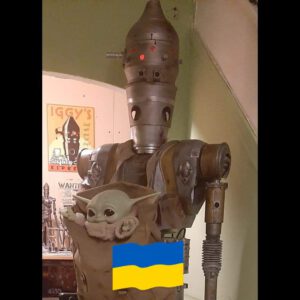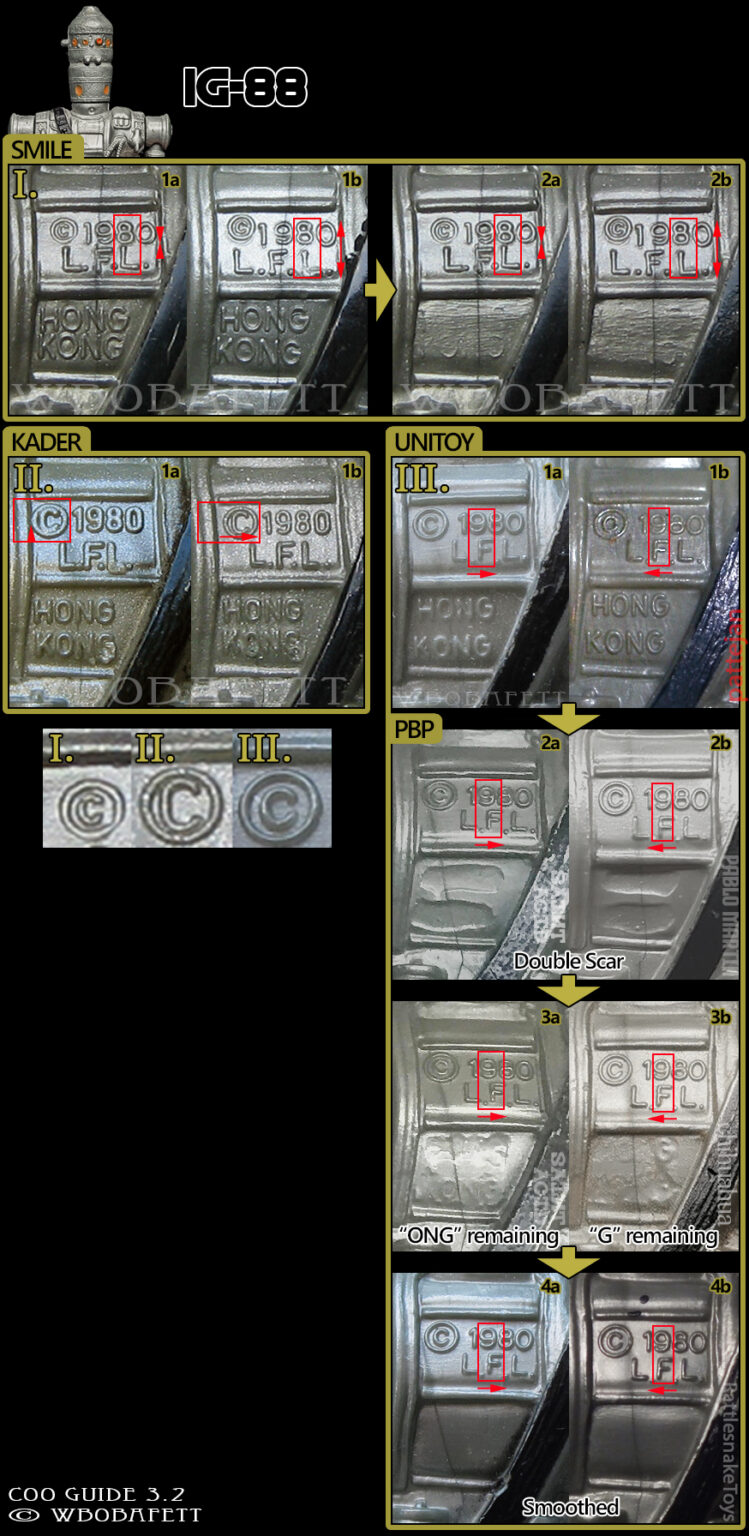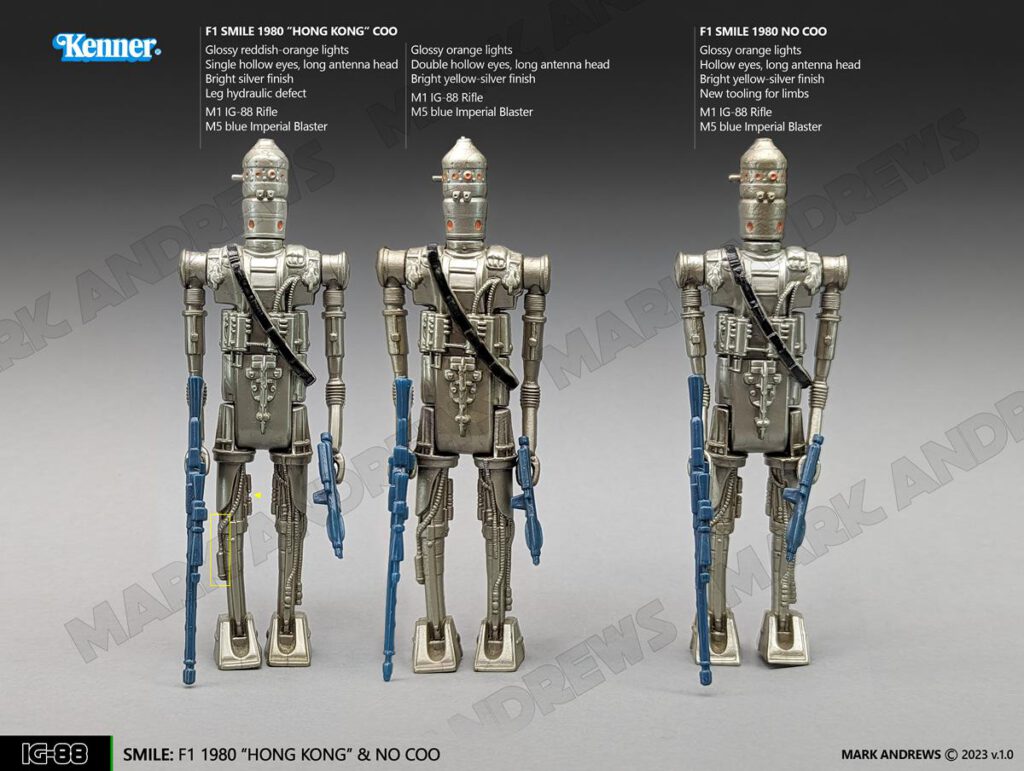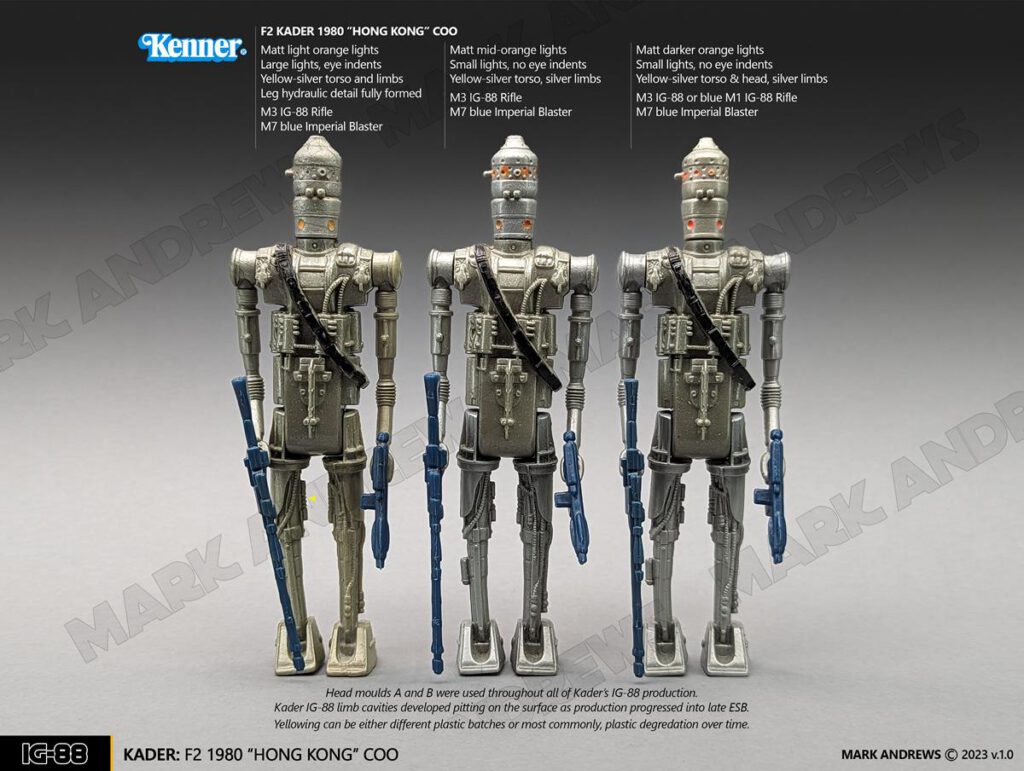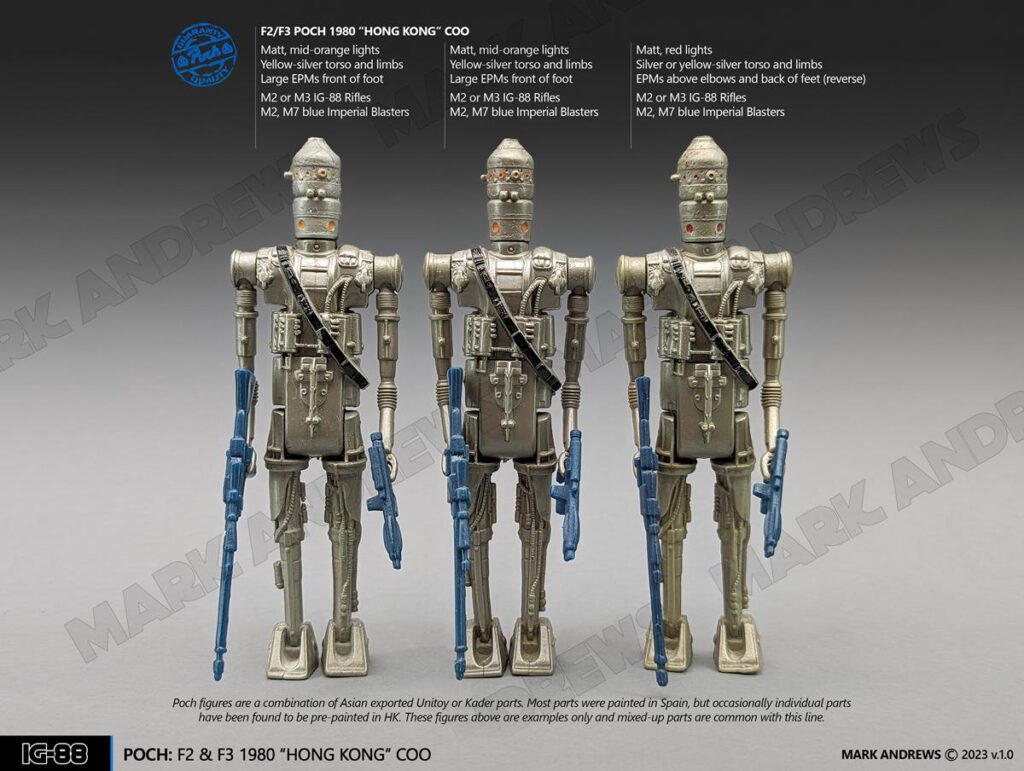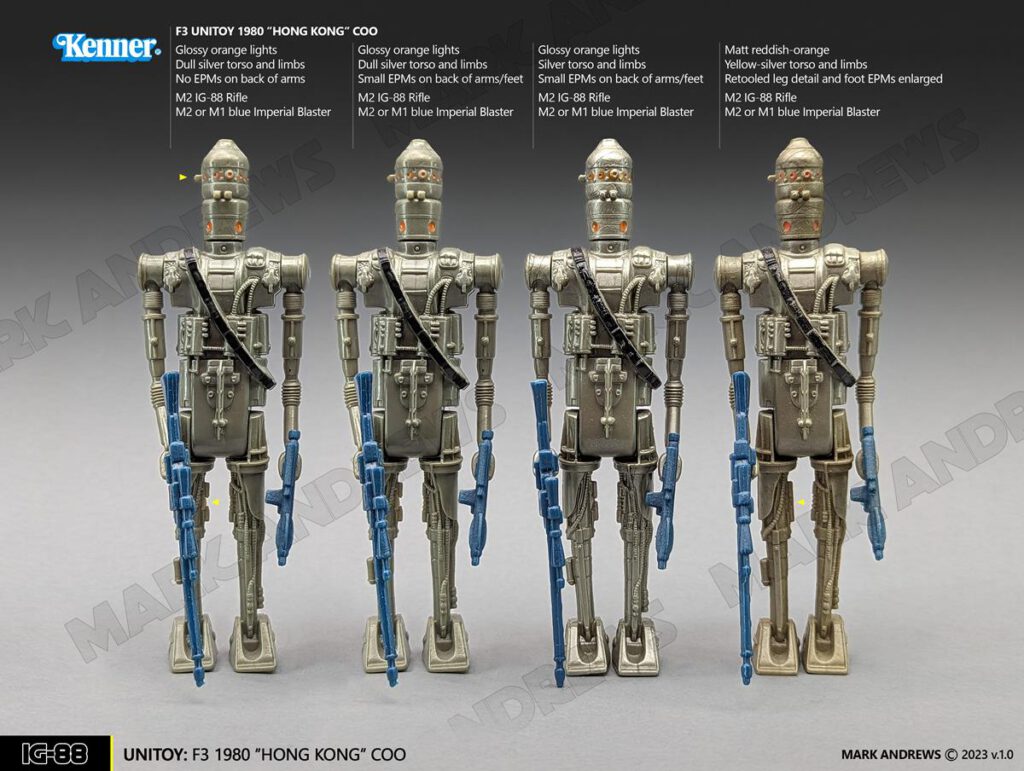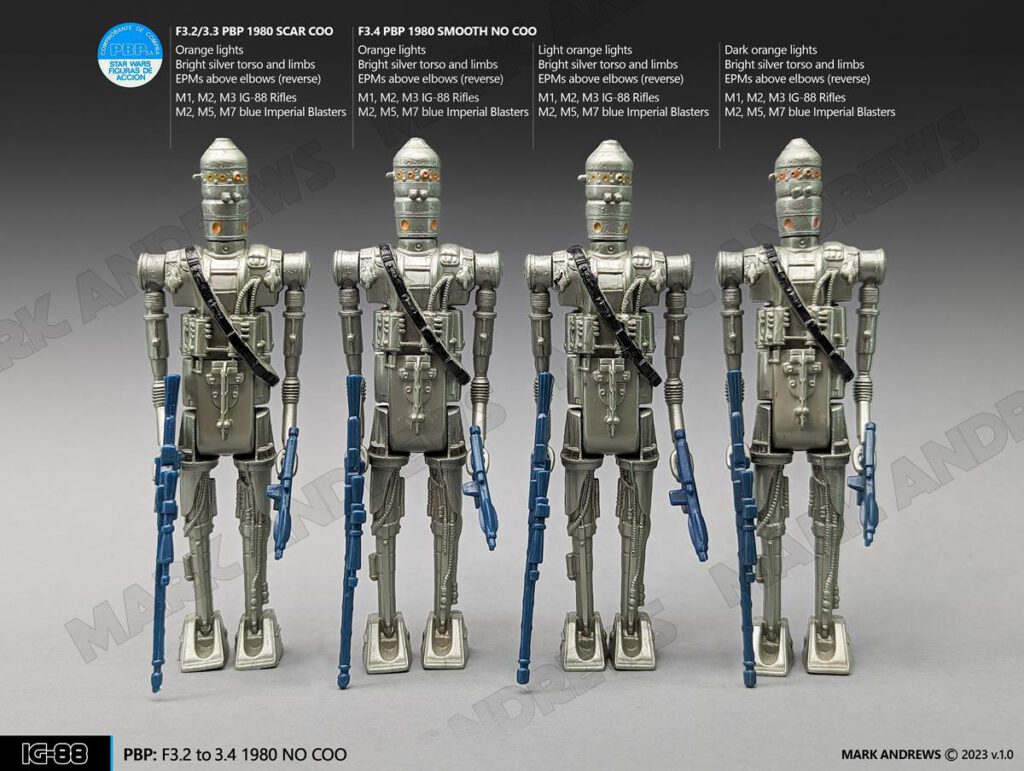IG-88
SMILE 1980 HONG KONG or No COO
Above you can see following figure and accessory combinations (left to right):
- Hong Kong COO Single eyes w/glossy reddish-orange lights
- Hong Kong COO Double eyes w/glossy orange lights
- No COO Single eyes w/glossy orange lights
The Smile IG-88 stands out thanks to the brilliant silvery sheen on the plastic Smile used to form the figure.
Smile IG-88 debuted in the 31 back era and was consistently released through nearly all of the Kenner cardback eras up to 77, then onto Trilogo.
The initial version of the Smile figure features glossy reddish-orange lights, a long antenna and hollowed out eyes. There’s an extra pipe moulded on the outer right leg which the other two moulds don’t feature. The inside right leg suffered a moulding flaw where the molten plastic often didn’t flow completely into the hydraulic detail, leaving a unfinished gap (see graphic below). The lights were altered to a glossy mid orange in the 41 back era.
If you look closely you can see the head mould had the hollowed eyes stamped twice into one of the cavities, resulting in an odd “double-eye” effect (refer image 1 below). There was also two attempts to stamp the copyright C into one of the rear torso cavities.
The COO removal is a little unusual in that it’s coarsely “scratched” out instead of the smooth method more typically used in the Smile factory. This could be down to limited accessibility within the cavity. There’s also indications of some retooling on the rear torso shoulders of the No COO figure which I’ve highlighted below.
Towards the end of the HK COO era, signs of wear begins to show in the limb & head mould cavities, resulting in a rough texture on the limbs and head. To remedy the wear, the tools were replaced with a new set which feature some small mould variations including a larger foot. Figures with mixed limbs from both mould do exist.
ACCESSORY COMBINATION
KADER 1980 HONG KONG
Above you can see following figure and accessory combinations (left to right):
Hong Kong COO Large, matt light orange lights. Yellow-silver torso & limbs. Hydraulic detail fully formed
Hong Kong COO Small, matt mid-orange lights. Yellow-silver torso, silver limbs
Hong Kong COO Small, matt darker orange lights. Yellow-silver torso & head, silver limbs
Kader IG-88 can first be found on the 32 back and Palitoy 30bk. The early Kader version is a surprisingly hard to find ESB release, with Kader production ramping up from the 48 back ROTJ card onwards. Also strangely, Kader didn’t remove the COO from their figure, despite producing the figure through to the 77bk, and into the Trilogo era when COOs were removed.
The first Kader versions had matt lighter orange lights which became more vibrant in the Trilogo era.
There are two head moulds which appeared throughout the whole production run. There’s a number of minor variations, but the size of the “lights” is the easiest tell. The Kader head mould should feature tiny pin-sized indents on the eyes, and without the pin eyes suggests a slightly imperfect plastic shot (refer image below). Comparing Kader IG-88 first shots, you can see there was some early retooling prior to production, with a thinner antenna and larger eyes being most notable. This work would have been done by hand directly in the cavities, and would explain the reason there’s two Kader IG head moulds (refer to image 1 below).
The figure commonly has torso and limbs in a various shades of silver. The mix of shades I’ve shown above is a broad overview and other combinations exist. Although minor colour variations in the plastic granules used to form the parts exist, most yellowed Kader examples are bound to be degraded.
Perhaps due to his unusual size compared to other figures from the line, Kader IG-88 suffered a lot of melt marks during the sonic welding process. Most obvious is the often melted COO on the back of the figure (refer image 2 below).
As with the other Asian producers, the Kader inside right leg suffered a moulding flaw where the molten plastic often didn’t flow completely into the hydraulic detail, leaving a unfinished gap. After a period of time, pitting to the limbs and head mould cavities began to present. This pitting has also been noted on other Kader produced figures and accessories. To remedy these issues, the IG-88 moulds had some retooling just prior to the 77bk era to correct both the plastic flow and the pitting across the surface (refer image 3 below).
ACCESSORY COMBINATIONS
M3 Kader IG-88 Rifle or (later) M1 Kader blue IG-88 Rifle (former Smile mould)
M7 Kader IG-88 blue Imperial Blaster or (later) M4 Kader blue Imperial Blaster
POCH 1980 HONG KONG
Above you can see following figure and accessory combinations (left to right):
Light orange lights. Kader head, arms, legs. Unitoy torso
Light orange lights. Kader head and legs. Unitoy arms and torso
- Red lights. Kader head. Unitoy torso, arms and legs
Poch figures are sourced from a combination of Asian produced Unitoy or Kader parts which were exported to Spain in the late ESB era. The red lights IG-88 is thought to be an earlier Imperio release.
The Kader IG-88 parts which Poch used have the same pitting found on other late ESB Kader moulds.
There are two main colours for the lights on this figure – red and light orange. The light orange used is very similar to Kader, just a shade glossier. The orange Poch used can also be found on FX-7 and their Power Droid.
Poch IG-88 is one of the more difficult figures to identify from his Kenner cousin. Common melt marks, plastic burrs, excess flashing, heavy plastic welding, mixed-up factory parts or paint overspray and bubbles are all signs that can be used to help confirm a figures origins.
UNITOY 1980 HONG KONG
Above you can see following figure and accessory combinations (left to right):
Hong Kong COO Dull grey body with glossy orange lights. No EPMs
Hong Kong COO Dull grey body with glossy orange lights
Hong Kong COO Silver body with glossy orange lights
Hong Kong COO Yellow-silver body with glossy orange lights. Enlarged EPMs
Unitoy IG-88 debuted in the 31 back era and had a relatively short run only continuing to the 41 back. The first Unitoy IG-88 is quite eye catching with his peculiar dull grey surface. Midway into the 32bk release, I’m presuming Kenner must have instructed the factory to alter the plastic to achieve a more metallic silver finish.
The glossy orange lights are fairly consistent with this figure, though some minor variations exist, such as the matt reddish-orange example on the right in the image above.
There were a number of retooling procedures to this mould. The moulds were initially created without ejector pins. These were added to the back of the arms very shortly after production began. At some point through the Unitoy production run, new limb tooling was produced with minor moulding detail variations and larger foot ejector pins (see image below).
Again, the inside right leg suffered the same moulding flaw as the other moulds where the molten plastic often didn’t always flow completely into the hydraulic detail, leaving an unfinished gap.
As with other Unitoy character releases from this era, their production of IG-88 ceased mid-ESB on the 41 cardback release. The moulds resurface again in Spain in the NCOO figure from PBP.
ACCESSORY COMBINATION
M2 Unitoy IG-88 Rifle
M2 Unitoy blue Imperial Blaster and more uncommonly the M1 Unitoy blue Imperial Blaster
PBP 1980 No COO
Above you can see following figure and accessory combinations (left to right):
Scar No COO Bright silver w/glossy orange lights.
Smooth No COO Bright silver w/glossy orange lights
Smooth No COO Bright silver w/light orange glossy lights
Smooth No COO Bright silver w/dark orange glossy lights
PBP in Spain received the moulds from the Unitoy factory in Hong Kong to produce their No COO version of IG-88. The colour is lighter, and more metallic than the Unitoy counterpart. This IG-88 isn’t shot in the same rigid, brittle plastic typically associated with PBP figures.
PBP used a temporary filler to blot out the Hong Kong COO, however the initial attempt didn’t hold. This first attempt (3-2 a/b) is the traditional PBP scarring method, but in very short time, the filler broke apart exposing the letters beneath as shown in 3-3 a/b) The final and successful attempt at COO removal filled the entire recess instead of just covering the letters (refer image below).
The arm EPMs are noticeably longer on the PBP version as the pins weren’t set correctly, and didn’t return to a flush position in the cavity for each new shot, resulting the longer protrusion.
As with the Kader and Poch versions, there are melt marks commonly found in certain areas of the torso. However, this is not a certainty and figures without melt marks have also been noted.
As with the earlier POCH-era figures from this same factory, melt marks tend to be found in the same locations, though some Spanish made IG-88 figures are found without melts altogether.
ACCESSORY COMBINATION
M1 Smile, M3 Kader or M2 Unitoy IG-88 Rifle
M5 Smile, M7 Kader or M2 Unitoy blue Imperial Blaster
There’s not enough surviving PBP MOC examples to say with certainty about accessory pairing. Much of this is based on information from Spanish collectors who found these combinations in childhood lots over the years. Logically, Smile and Kader IG accessories were still in production during the PBP era and make the most sense. The Unitoy IG accessory would have been in Spain from the early Poch era and excess stock could very possibly have ended up packaged with the later made PBP IG-88 figures.
I’d like to thank Tim Emmerson, Wolff Lipinski, Stefan Callear, Ahmed Boukarrouh, James Gurney and Pablo Martin for their help in the making of the IG-88 guide.
As much as I’ve taken a lot of care to track down and detail these variations, there’s bound to be examples that aren’t included. If you believe you have a colour which isn’t featured, please get in touch via VV Facebook or the form on the VV homepage. Thanks.
